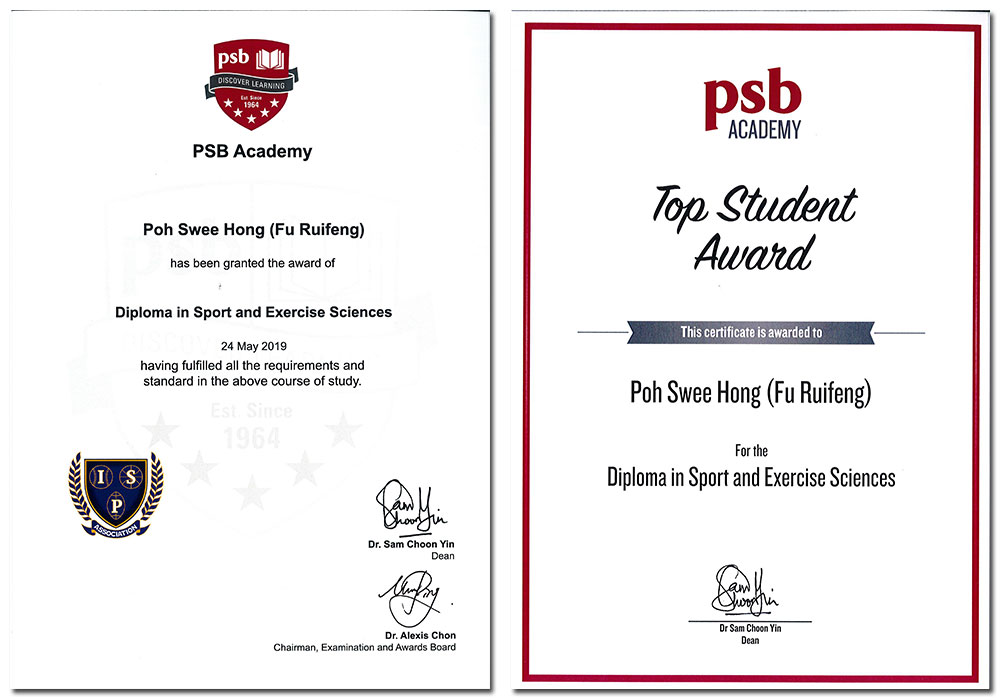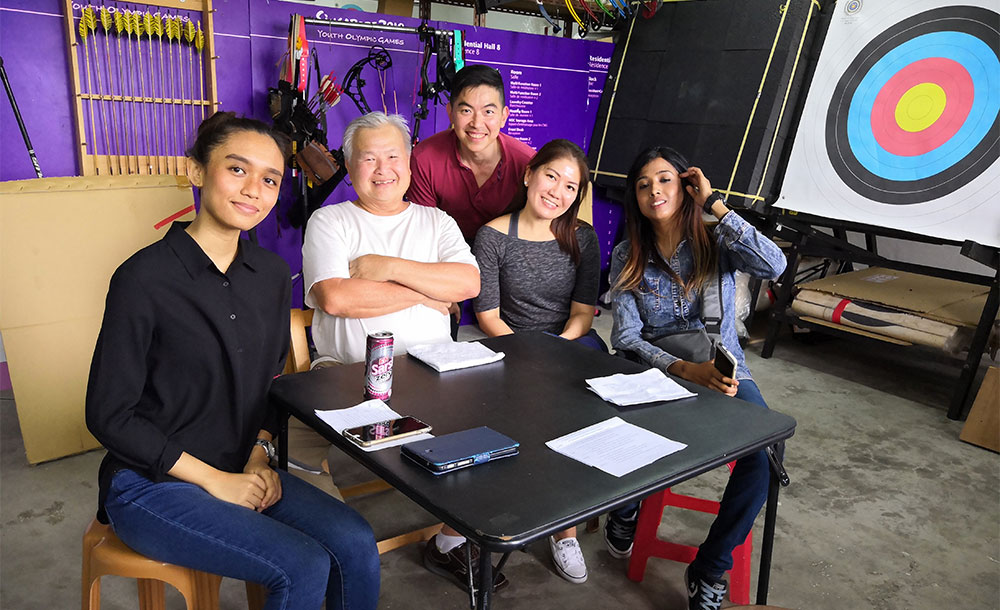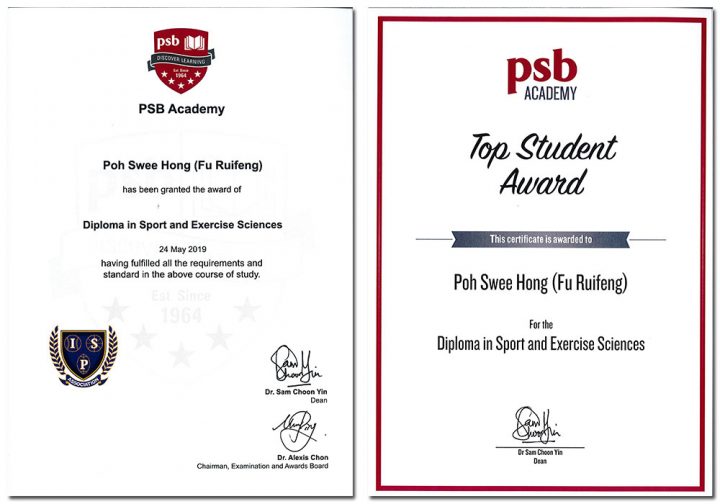I recently collected my final piece of certificate for the PSB Academy Diploma in Sport and Exercise Sciences. I completed the final exam in March 2019, graduated and collected the diploma in May. Surprisingly, I was also the top student for my batch. I had not expected this.

2 years ago, I was interested to take a sport science course. There were limited schools offering this course in Singapore. One was Republic Polytechnic, and the other PSB Academy. Republic poly was too far for me, considering I will need to attend classes a few times a week. Hence, I opted for PSB Academy instead.
Diploma in Sport and Exercise Sciences – The Modules
I am going to share a bit about the 8 modules that I took for the Diploma in Sport and Exercise Sciences. Passing the 8 modules will award you with the Diploma in Sport and Exercise Sciences. With the diploma, you can also top-up towards the degree course.
The part-time diploma course can be completed in one year, and there is a new intake every quarter. You can start in any quarter, taking 2 modules per quarter. Here are the 8 modules I took from April 2018 to March 2019.
1. Principles of Weight Training
“This course provides a comprehensive coverage of weight training exercises for the upper and lower body, using free weights and machines. It provides coverage on proper technique and performance through analysing movements, detailing safety precautions, and identifying common errors. This course has a practical component where students will design and implement a weight training program in the gym.”
– PSB Academy module guide, 2018
Mr. David Heng taught my batch for this module. The written exam is 40% of the final score, and the individual practical assessment 60%. The practical assessment focused on individual weight training technique, spotting technique and safety consciousness of weight training. The assessment is conducted as a student pair. Each student takes turn to be a PT to the other, providing exercise instructions based on a muscle group, and helping to spot.
I enjoyed this module a lot, as it is reminds me of the Les Mills BODYPUMP® classes I attend at the gym. Unfortunately, out of my 8 modules, I had the lowest grade for this module. Sad.
2. Sport & Exercise Nutrition
“This course aims to present the principles, background, and rationale for current nutrition guidelines specifically for athletes and exercise participants. Using a physiological basis, this course provides an in-depth look at the science behind sport nutrition. Students will come away with a comprehensive understanding of nutrition as it relates to sport and the influence of nutrition on exercise performance, training, and recovery.”
– PSB Academy module guide, 2018
Mr. Andrew Chin taught me this module. The written exam is 40% of total grade. The group project is 60%. It was the first term and I was unfamiliar with everyone. So, I ended up doing the project on my own. In this project, I had to document a 3-day food & activities log, to understand the relationship between my energy expenses and nutritional intake requirements. If you happen to be taking this module, and want to take a peek at my report, please contact me at the bottom of this page and let me know.
I found it very useful documenting my food intake and exercise output. This is different from my usual carbohydrates counting, to determine my pre-meal (and sometimes post-meal) dose of glulisine.
If you are interested, here’s the Insulin Dosage Calculator I created. It helps me to determine the dose of insulin, or amount of carbohydrates I need, to bring my blood glucose to a target range. The preset values in the calculator is based on my insulin sensitivity, but anyone who knows his or her sensitivity can also use it.
3. Sport & Exercise Psychology
“This course examines psychological theories and research related to sport and exercise behaviour. The course is designed to introduce the student to the field of sport and exercise psychology by providing a broad overview of the major topics in the area. Examples of some of the interesting topics covered include motivation, group cohesion, psychological skills training methods, exercise behaviour, psychology of injury, and burnout & over training.”
PSB Academy module guide, 2018
Ms. Sanjana Kiran taught me this module. The written exam makes up 40% of the final score. The other 60% is a team presentation and written report. The topic assigned to my team is “FOCUS”. You can take a look at our report and presentation slides. The content is pretty generic.
4. Physiology of Sport & Exercise
“This course aims to introduce the physiological responses associated with sport and exercise participation. Topics covered include exercising muscles, cardiovascular & respiratory function, exercise training, environmental influences on performance, performance optimisation, and age & sex considerations in sport & exercise.”
– PSB Academy module guide, 2018
Dr. Aaron Sim taught us this module. The written exam is 40% of the final score, and a group project for 60%. For this project, we need to select a sport, identify the target audience/goals, and create a 8-week periodisation plan to achieve this goal.
My team did not have any particular preference, so I managed to convince them with my idea. Our report was titled “8 WEEK PERIODISATION PLAN FOR FLAMING ARROWS ARCHERY CLUB IN PREPARATION FOR NUS ARCHERY INDOOR CHAMPIONSHIP 2019“. The club and competition is real, but the application is fictitious.
5. Methods of Group Exercise Instruction
“This course provides content knowledge and practical experience concerned with teaching and evaluating group exercise classes. A variety of group exercise classes will be introduced. This course has a practical component where students will design and lead a group exercise class.”
– PSB Academy module guide, 2018
Mr. Nick Tan taught me this module. The written exam is 40%, and the group project 60%. There is no report to submit. We had to pick music tracks, and meet up regularly to design and practice a group exercise choreography that we need to lead an assigned group of exercisers.
Again, it felt like attending a group exercise class at the gym. Our target group was housewives, aged 30-50, who rarely exercise. Our choreography was mainly aerobics and body-resistance exercises. My group mate, Caroline, came up with the choreography. She used to be a group exercise instructor, and is now a personal trainer at her own gym. So it is totally up her alley!
Do check out her gym, Physique 360!
6. Biomechanics of Sport & Exercise
“This course is an introduction to the discipline of biomechanics applied to sport and exercise settings. The course will focus on practical concepts such as external forces and their effects, how the body generates forces to maintain position, and how forces create movement in physical activities. In addition, emphasis will also be given to help students apply biomechanical principles to improve sports techniques, exercise training, and injury prevention.”
– PSB Academy module guide, 2018
Mr. Andrew Chin taught us this module. The written exam is 40% of the final result, and a written group report is 60%. For the report, we had to pick a sport and apply biomechanical principles essential to improving technique, performance and reducing injury. The new and interesting thing we had to do, was to make use of Kinovea, a sports video analysis software.
This was something interesting! I never knew such a tool was available for free, and relatively easy to use. Again, for this project, we did an analysis for archers. Here’s the report for reference.
7. Functional Anatomy
“This course is designed to introduce the structures of human anatomy and explain how these structures are involved in human movement. Topics covered will include bones, ligaments, muscles, joints, blood vessels and nerves of the human body. Students also gain from having hands-on experiences performed on themselves or a partner to enhance the learning and understanding of human anatomy.”
– PSB Academy module guide, 2019
Mr. Nick Tan taught us this module. The written exam is 40%, and remaining 60% is an individual practical assessment. In this practical exam, we are required to identify 30 bones, ligaments and major joints of the human body. How the assessment was conducted is pretty fun. It was like a musical chair, and we had 90 seconds (if I remembered correctly) at each station to identify the parts from pictures or anatomical models.
However, this module is pretty tough for most students. There are a lot of things to memorise.
8. Professional Studies
“This module aims to survey the professional field of sport and leisure. Students will get the opportunity to analyse the nature and importance of physical activity, the knowledge base associated with the professional field, and careers in physical activity professions (e.g., sport, exercise, fitness, physical education, coaching, and management). Focus will also be placed on the integrative nature of the professional field.”
– PSB Academy module guide, 2019
Mr. Edgar Tham taught us this module. As with all other modules, the written exam is 40% of the final score. The remaining 60% is from a group presentation. For this project, we need to interview a professional in the sports industry. The final submission consists of a team presentation in class, and a written report.

My group interviewed my archery coach, Mr. George Loh. A video recording of about 15 questions was also required. For the presentation, we were only required to show videos for 3 questions, one each for a “Past”, “Present” and “Future” question. Here are the 3 videos.
Professional Studies is normally the first module, as it is conducted in the first quarter (Jan-Mar) of the year. It was meant to set the mood of why we study this course. However, I ended up taking it last, as I enrolled in April.
Diploma in Sport and Exercise Science – What’s Next?
So, what’s next after getting the Diploma in Sport and Exercise Sciences? Those interested to continue further can take the Bachelor Of Science Sport And Exercise Science programme awarded by Edinburgh Napier University. This course is offered by PSB Academy.
Alternatively, as I already have a basic degree, and “some” experience in the sports industry, another option for me is to skip the Bachelor degree and go direct to the Master of Science (Exercise and Sport Studies) course at NTU. However, I have decided at this point in time, not to carry on, as I am pretty happy with my job now, and have no intention to move to the sports industry. I’ll spend my time on learning something else.
If you have any questions about the course, feel free to drop me an message below.
